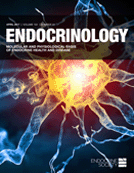-
Views
-
Cite
Cite
ICHIRO SHIMIZU, MEISEI HIROTA, CHIZUKO OHBOSHI, KENJI SHIMA, Identification and Localization of Glucagon-Like Peptide-1 and Its Receptor in Rat Brain, Endocrinology, Volume 121, Issue 3, 1 September 1987, Pages 1076–1082, https://doi.org/10.1210/endo-121-3-1076
Close - Share Icon Share
Abstract
The existence and distribution of glucagon-like peptide-l (GLP-1) and its receptor in rat brain in relation to that of glucagon were examined. The concentration of GLP-1 immunoreactivity (GLP-1-IR), measured by a specific and sensitive RIA established in this study with anti GLP-1 serum (LMT-01), was found to be highest in the thalamus-hypothalamus, followed by the medulla oblongata. The distribution of glucagon-like immunoreactivity was similar to that of GLP-1- IR. However, appreciable glucagon immunoreactivity was detected only in the thalamus-hypothalamus. Gel filtration analysis showed the presence of GLP-1-IR of various molecular weights in the extract of thalamus-hypothalamus including that eluted at the same position as synthetic GLP-1 (1-37); moreover, HPLC analysis also confirmed the presence of GLP-1-IR, eluted at the exact position as synthetic GLP-1 (1-37). The distribution of receptors for GLP-1 corresponded with that of GLP-l-IR in the rat brain, except in the pituitary gland. The distribution of these receptors was also similar to that of glucagon receptors. The thalamus-hypothalamus, pituitary gland, and medulla oblongata were rich in GLP-1 and glucagon-binding sites. The binding affinities of GLP-1 and glucagon were in the nanomolar range [disocciation constant Kd = 4 nM]. The presence of specific, high affinity receptors for GLP-1 was confirmed by demonstrating that GLP-1 stimulated cAMP formation in the thalamus- hypothalamus and the pituitary gland. The concentration of GLP-1 required for half-maximal stimulation of cAMP formation in these regions was about 1 nM. These results suggest that GLP-1 may be synthesized in certain parts of the brain and play a role as a neurosignal transmitter. (Endocrinology121: 1076–1082, 1987)





